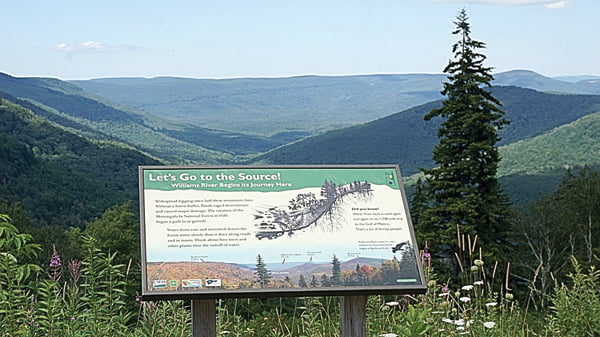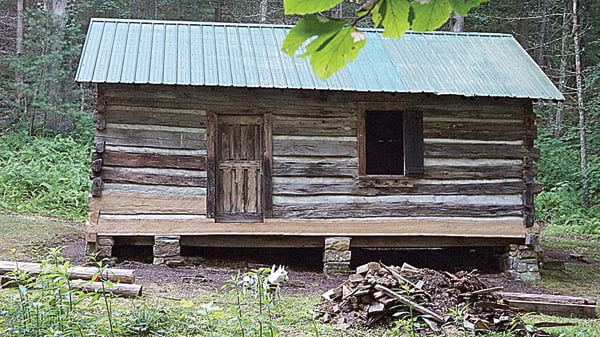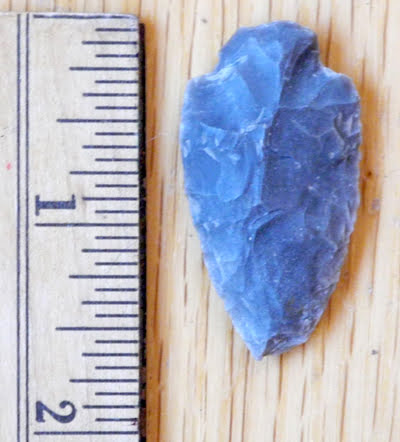
The Future of
Watoga’s History
History is generally not the first thing to come to mind when we think about visiting a park unless we are visiting Droop Mountain State Park or Antietam National Battlefield.
Watoga State Park is a park of great natural beauty, and hiking on her trails may make you feel as though you are walking through untrodden terrain. But your footsteps fall upon those of others that go back thousands of years. The deep hollows and coves of Watoga echo with many voices, many languages and many motivations.
The area we now call Watoga State Park was considered home to many people long before the park opened its doors to the public in 1937.
A flint projectile found in Jeff’s Hollow in 2017 was determined to be an archaic stone tool. You can well imagine hunter/gatherers grasping a spear and atlatl as they ventured through the primeval forests that clad these ancient mountains of Pocahontas County.
Artifacts reveal that Paleo-Indians were hunting and gathering among the hills and valleys along the Greenbrier River for thousands of years. These finds re-open the debate about who discovered North America. The archaeological evidence strongly suggests that these early arrivals appeared sometime during the last ice age; millennia before Christopher Columbus set sail.
John Lederer, a German physician and explorer, is credited with being the first European to venture into what is now West Virginia in 1669. And closer to home, Jacob Marlin and Stephen Sewell were the first known non-native settlers in the Greenbrier River Valley in 1749. The two built a cabin in the area that was later to become Marlinton. Religious differences between the two famously led to Sewell moving out of the cabin and taking up housekeeping in a hollowed-out sycamore tree. Now that is a bit of history worth repeating for a few hundred years!

Narrowing down our focus to the area of land that comprises the 10,000 plus acres of Watoga State Park, we find even more history. We do know that there are a number of homestead locations in the park including the Workman Cabin which is currently being restored. There is a home site near the TM Cheek trail that may have also served as a school for the children of local families. Further study of these early residents of Pocahontas County is being vigorously conducted.
One of the most significant eras associated with Watoga State Park is that of the Civilian Conservation Corps, or as it is better known, the 3-C. This much-lauded program arose Phoenix-like out of the lean years of the Great Depression.
In the early years of the Great Depression, jobs, particularly for young men, in the jargon of the day, “couldn’t be had for love nor money.”
Much of the infrastructure you see in Watoga was built by the CCC, including the cabins, roads, lake, trails, swimming pool, administration buildings and, of course, the iconic Ann Bailey Tower.
Watoga was home to no less than three CCC camps; Watoga, Seebert and the short-lived Will Rogers Camp.
The beautiful handiwork of these young men can be found throughout the park.
And as the park matured, changes were made to reflect those in society at large; improved roads, modern appliances in the cabins and upgraded utility systems. But this was not done at the expense of the aesthetics of the National Park Service inspired architecture and design. Staying in one of the Legacy cabins will, in itself, be a history lesson on what it was like to live in a pioneer cabin; right down to the smallest detail.

There is one thing that could greatly improve the experience of the park visitor – it is short on interpretive signs at significant locations, be they historical or scenic. This was brought to the attention of the Watoga State Park Foundation by Mac Gray after seeing the wonderful signs the Forest Service installed at the overlooks along the Scenic Highway and at the old Mill Point Prison at Cranberry Glades.
The foundation recently voted to take on the project of purchasing such signs, pursuant to the approval of the Watoga State Park superintendent. If fully approved, an initial inventory of the park’s scenic and historical sites will be conducted.
Superintendent Jody Spencer has shown, time and time again, the ability and willingness to anticipate and find value in those things that create a richer experience for the park visitor. Improvement of the camp- grounds, heating the swimming pool, upgrades to the cabins, restoration of the Workman Cabin and Cemetery and the new dedicated games area at the old airfield are testaments to his commitment to creating the best park possible.
West Virginia state parks are among the finest state parks in the country because of the evident concern for the history and culture of the area in which the parks reside. They also manage the difficult task of protecting nature while providing a safe and worthwhile experience for the visitor.
The future holds great things for Watoga State Park. Already a park brimming over with natural beauty, it stands to create new educational opportunities through the restoration of historically significant sites and state-of-the-art interpretive signage.
Future plans include improving access to historical sites and a non-invasive interpretive trail into the Old Growth Area.
When you think about it, Watoga State Park is truly a gem of a park, and we have it all right here in Pocahontas County.
Happy hiking, and remember- hiking burns 430 calories per hour – a Moon Pie contains 110 calories and an RC Cola has 160 calories. If my calculations are correct you could hike an hour and make up for that Moon Pie and RC Cola you had for lunch and still have a deficit of 160 calories.
Did you really have a Moon Pie and cola for lunch?
Ken Springer,
The Trail Guy
Ken49bon@gmail.com


